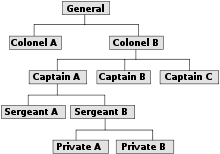- Organizational chart
-
 The organization chart for the Wikimedia Foundation (April 2009). This is an example of a hierarchical organization chart.
The organization chart for the Wikimedia Foundation (April 2009). This is an example of a hierarchical organization chart.
An organizational chart (often called organization chart, org chart, organigram(me), or organogram(me)) is a diagram that shows the structure of an organization and the relationships and relative ranks of its parts and positions/jobs. The term is also used for similar diagrams, for example ones showing the different elements of a field of knowledge or a group of languages.
The French Encyclopédie published in France between 1751 and 1772 had one of the first organizational charts of knowledge in general.[1] The Scottish-American engineer Daniel McCallum (1815–1878) is credited for creating the first organizational charts of American business[2] around 1854 [3].
Contents
Overview
An organizational chart of a company usually shows the managers and sub-workers who make up an organization. It also shows the relationships between directors : managing director chief executive officer: various departments... In many large companies the organization chart can be large and incredibly complicated and is therefore sometimes dissected into smaller charts for each individual department within the organization.
There are three different types of organization charts:
- Hierarchical
- Matrix
- Flat (also known as Horizontal)
Limitations
There are several limitations of organizational charts:
- If updated manually, organizational charts can very quickly become out-of-date, especially in large organizations that change their staff regularly.
- They only show 'formal relationships' and tell nothing of the pattern of human (social) relationships which develop. They also often do not show horizontal relationships.
- They provide little information about the managerial style adopted (e.g. 'autocratic', 'democratic' or an intermediate style)
- In some cases, an organigraph may be more appropriate, particularly if one wants to show non-linear, non-hierarchical relationships in an organization.
- It often does not include customers.
Examples
The following is an example of a simple hierarchical organizational chart is the image-chart on the right.
An example of a 'line relationship' (or chain of command in military relationships) in this chart would be between the Manager and the two Supervisors. These two colonels are directly responsible to the general.
An example of a 'lateral relationship' in this chart would be between "Foreman A", and "Foreman B" who both work on level and both report to the "Workers A".
Various shapes such as rectangles, squares, triangles, circles etc. can be used to indicate different roles. Colour can be used both for shape borders and connection lines to indicate differences in authority and responsibility, and possibly formal, advisory and informal links between people. A department or position yet to be created or currently vacant might be shown as a shape with a dotted outline. Importance of the position may be shown both with a change in size of the shape in addition to its vertical placement on the chart.
See also
References
- ^ See Figurative system of human knowledge
- ^ Alfred D. Chandler, Jr. (1962). Strategy and Structure: Chapters in the History of the American Industrial Enterprise. Cambridge, MA: MIT Press
- ^ Burton S. Kaliski (2001). Encyclopedia of business and finance. p.669
External links
See also: template Aspects of corporations · template Aspects of occupations · template Aspects of workplaces · Architecture · Blame · Burnout · Capital · Chart · Citizenship behavior · Climate · Commitment · Communication · Complexity · Configuration · Conflict · Culture · Design · Development · Diagnostics · Dissent · Ecology · Effectiveness · Engineering · Ethics · Field · Hierarchy · Identification · Intelligence · Justice · Learning · Life cycle · Mentorship · Network analysis · Ombudsman · Onboarding · Patterns · Perceived support · Performance · Politics · Proactivity · Psychology · Resilience · Retaliatory behavior · Safety · Space · Storytelling · Structure · Studies · Suggestion boxCategories:- Diagrams
- Organizational studies and human resource management
- Organizational theory
Wikimedia Foundation. 2010.

